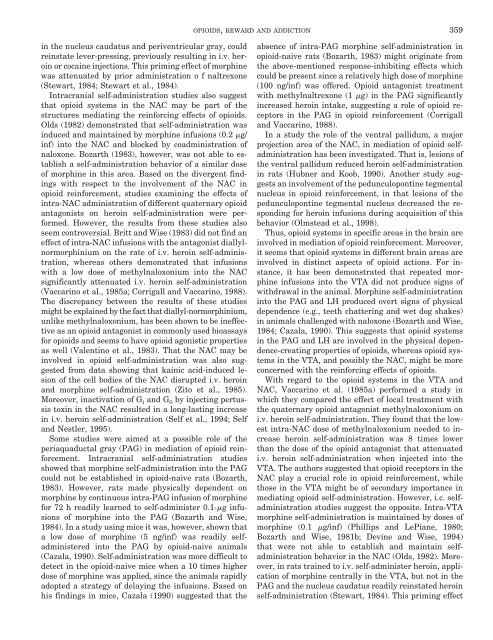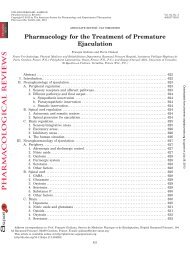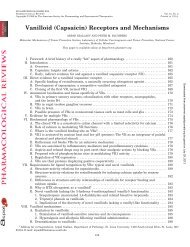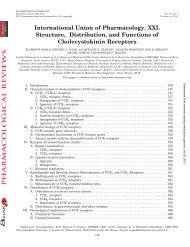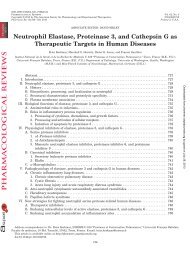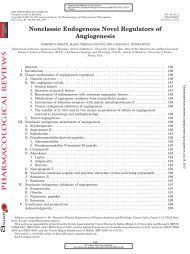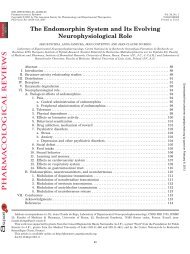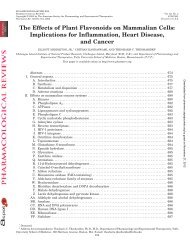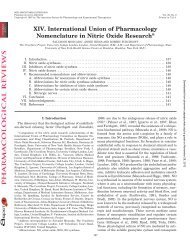Opioids, Reward and Addiction: An Encounter of Biology ...
Opioids, Reward and Addiction: An Encounter of Biology ...
Opioids, Reward and Addiction: An Encounter of Biology ...
Create successful ePaper yourself
Turn your PDF publications into a flip-book with our unique Google optimized e-Paper software.
in the nucleus caudatus <strong>and</strong> periventricular gray, could<br />
reinstate lever-pressing, previously resulting in i.v. heroin<br />
or cocaine injections. This priming effect <strong>of</strong> morphine<br />
was attenuated by prior administration o f naltrexone<br />
(Stewart, 1984; Stewart et al., 1984).<br />
Intracranial self-administration studies also suggest<br />
that opioid systems in the NAC may be part <strong>of</strong> the<br />
structures mediating the reinforcing effects <strong>of</strong> opioids.<br />
Olds (1982) demonstrated that self-administration was<br />
induced <strong>and</strong> maintained by morphine infusions (0.2 g/<br />
inf) into the NAC <strong>and</strong> blocked by coadministration <strong>of</strong><br />
naloxone. Bozarth (1983), however, was not able to establish<br />
a self-administration behavior <strong>of</strong> a similar dose<br />
<strong>of</strong> morphine in this area. Based on the divergent findings<br />
with respect to the involvement <strong>of</strong> the NAC in<br />
opioid reinforcement, studies examining the effects <strong>of</strong><br />
intra-NAC administration <strong>of</strong> different quaternary opioid<br />
antagonists on heroin self-administration were performed.<br />
However, the results from these studies also<br />
seem controversial. Britt <strong>and</strong> Wise (1983) did not find an<br />
effect <strong>of</strong> intra-NAC infusions with the antagonist diallylnormorphinium<br />
on the rate <strong>of</strong> i.v. heroin self-administration,<br />
whereas others demonstrated that infusions<br />
with a low dose <strong>of</strong> methylnaloxonium into the NAC<br />
significantly attenuated i.v. heroin self-administration<br />
(Vaccarino et al., 1985a; Corrigall <strong>and</strong> Vaccarino, 1988).<br />
The discrepancy between the results <strong>of</strong> these studies<br />
might be explained by the fact that diallyl-normorphinium,<br />
unlike methylnaloxonium, has been shown to be ineffective<br />
as an opioid antagonist in commonly used bioassays<br />
for opioids <strong>and</strong> seems to have opioid agonistic properties<br />
as well (Valentino et al., 1983). That the NAC may be<br />
involved in opioid self-administration was also suggested<br />
from data showing that kainic acid-induced lesion<br />
<strong>of</strong> the cell bodies <strong>of</strong> the NAC disrupted i.v. heroin<br />
<strong>and</strong> morphine self-administration (Zito et al., 1985).<br />
Moreover, inactivation <strong>of</strong> G i <strong>and</strong> G 0 by injecting pertussis<br />
toxin in the NAC resulted in a long-lasting increase<br />
in i.v. heroin self-administration (Self et al., 1994; Self<br />
<strong>and</strong> Nestler, 1995).<br />
Some studies were aimed at a possible role <strong>of</strong> the<br />
periaquaductal gray (PAG) in mediation <strong>of</strong> opioid reinforcement.<br />
Intracranial self-administration studies<br />
showed that morphine self-administration into the PAG<br />
could not be established in opioid-naive rats (Bozarth,<br />
1983). However, rats made physically dependent on<br />
morphine by continuous intra-PAG infusion <strong>of</strong> morphine<br />
for 72 h readily learned to self-administer 0.1-g infusions<br />
<strong>of</strong> morphine into the PAG (Bozarth <strong>and</strong> Wise,<br />
1984). In a study using mice it was, however, shown that<br />
a low dose <strong>of</strong> morphine (5 ng/inf) was readily selfadministered<br />
into the PAG by opioid-naive animals<br />
(Cazala, 1990). Self-administration was more difficult to<br />
detect in the opioid-naive mice when a 10 times higher<br />
dose <strong>of</strong> morphine was applied, since the animals rapidly<br />
adopted a strategy <strong>of</strong> delaying the infusions. Based on<br />
his findings in mice, Cazala (1990) suggested that the<br />
OPIOIDS, REWARD AND ADDICTION 359<br />
absence <strong>of</strong> intra-PAG morphine self-administration in<br />
opioid-naive rats (Bozarth, 1983) might originate from<br />
the above-mentioned response-inhibiting effects which<br />
could be present since a relatively high dose <strong>of</strong> morphine<br />
(100 ng/inf) was <strong>of</strong>fered. Opioid antagonist treatment<br />
with methylnaltrexone (1 g) in the PAG significantly<br />
increased heroin intake, suggesting a role <strong>of</strong> opioid receptors<br />
in the PAG in opioid reinforcement (Corrigall<br />
<strong>and</strong> Vaccarino, 1988).<br />
In a study the role <strong>of</strong> the ventral pallidum, a major<br />
projection area <strong>of</strong> the NAC, in mediation <strong>of</strong> opioid selfadministration<br />
has been investigated. That is, lesions <strong>of</strong><br />
the ventral pallidum reduced heroin self-administration<br />
in rats (Hubner <strong>and</strong> Koob, 1990). <strong>An</strong>other study suggests<br />
an involvement <strong>of</strong> the pedunculopontine tegmental<br />
nucleus in opioid reinforcement, in that lesions <strong>of</strong> the<br />
pedunculopontine tegmental nucleus decreased the responding<br />
for heroin infusions during acquisition <strong>of</strong> this<br />
behavior (Olmstead et al., 1998).<br />
Thus, opioid systems in specific areas in the brain are<br />
involved in mediation <strong>of</strong> opioid reinforcement. Moreover,<br />
it seems that opioid systems in different brain areas are<br />
involved in distinct aspects <strong>of</strong> opioid actions. For instance,<br />
it has been demonstrated that repeated morphine<br />
infusions into the VTA did not produce signs <strong>of</strong><br />
withdrawal in the animal. Morphine self-administration<br />
into the PAG <strong>and</strong> LH produced overt signs <strong>of</strong> physical<br />
dependence (e.g., teeth chattering <strong>and</strong> wet dog shakes)<br />
in animals challenged with naloxone (Bozarth <strong>and</strong> Wise,<br />
1984; Cazala, 1990). This suggests that opioid systems<br />
in the PAG <strong>and</strong> LH are involved in the physical dependence-creating<br />
properties <strong>of</strong> opioids, whereas opioid systems<br />
in the VTA, <strong>and</strong> possibly the NAC, might be more<br />
concerned with the reinforcing effects <strong>of</strong> opioids.<br />
With regard to the opioid systems in the VTA <strong>and</strong><br />
NAC, Vaccarino et al. (1985a) performed a study in<br />
which they compared the effect <strong>of</strong> local treatment with<br />
the quaternary opioid antagonist methylnaloxonium on<br />
i.v. heroin self-administration. They found that the lowest<br />
intra-NAC dose <strong>of</strong> methylnaloxonium needed to increase<br />
heroin self-administration was 8 times lower<br />
than the dose <strong>of</strong> the opioid antagonist that attenuated<br />
i.v. heroin self-administration when injected into the<br />
VTA. The authors suggested that opioid receptors in the<br />
NAC play a crucial role in opioid reinforcement, while<br />
those in the VTA might be <strong>of</strong> secondary importance in<br />
mediating opioid self-administration. However, i.c. selfadministration<br />
studies suggest the opposite. Intra-VTA<br />
morphine self-administration is maintained by doses <strong>of</strong><br />
morphine (0.1 g/inf) (Phillips <strong>and</strong> LePiane, 1980;<br />
Bozarth <strong>and</strong> Wise, 1981b; Devine <strong>and</strong> Wise, 1994)<br />
that were not able to establish <strong>and</strong> maintain selfadministration<br />
behavior in the NAC (Olds, 1982). Moreover,<br />
in rats trained to i.v. self-administer heroin, application<br />
<strong>of</strong> morphine centrally in the VTA, but not in the<br />
PAG <strong>and</strong> the nucleus caudatus readily reinstated heroin<br />
self-administration (Stewart, 1984). This priming effect


